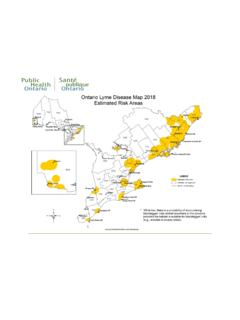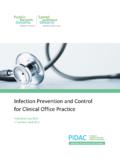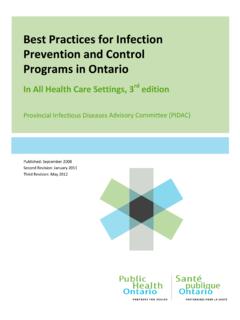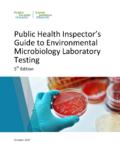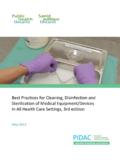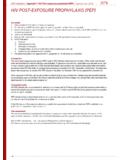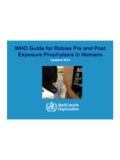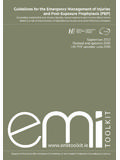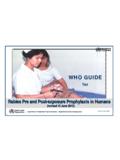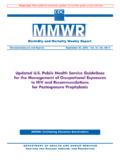Transcription of Hepatitis A Post-exposure Prophylaxis
1 Hepatitis A Post-exposure Prophylaxis (October 2013) i October 2013 Hepatitis A Post-exposure Prophylaxis Provincial Infectious Diseases Advisory Committee (PIDAC) Hepatitis A Post-exposure Prophylaxis (October 2013) i Public Health Ontario Public Health Ontario is a Crown corporation dedicated to protecting and promoting the health of all Ontarians and reducing inequities in health. Public Health Ontario links public health practitioners, frontline health workers and researchers to the best scientific intelligence and knowledge from around the world. Public Health Ontario provides expert scientific and technical support to government, local public health units and health care providers relating to the following: communicable and infectious diseases infection prevention and control environmental and occupational health emergency preparedness health promotion, chronic disease and injury prevention public health laboratory services Public Health Ontario s work also includes surveillance, epidemiology, research, professional development and knowledge services.
2 For more information, visit The Provincial Infectious Diseases Advisory Committee on Immunization (PIDAC-I) is a multidisciplinary scientific advisory body that provides evidence-based advice to the Ontario Agency for Health Protection and Promotion (Public Health Ontario) matters related to immunization. PIDAC-I provides advice by applying scientific knowledge and the best available evidence to vaccine programs and issues in Ontario, drawing on, but not repeating, the safety and efficacy analyses provided in the Canadian National Advisory Committee on Immunization (NACI) recommendations. Disclaimer for PIDAC documents: This document was developed by the Provincial Infectious Diseases Advisory Committee on Immunization (PIDAC-I). PIDAC-I is a multidisciplinary scientific advisory body that provides evidence-based advice to the Ontario Agency for Health Protection and Promotion (Public Health Ontario) regarding immunization.
3 PIDAC-I s work is guided by the best available evidence and updated as required. PHO assumes no responsibility for the results of the use of this document by anyone. This document may be reproduced without permission for non-commercial purposes only and provided that appropriate credit is given to Public Health Ontario. No changes and/or modifications can be made to this document without explicit written permission from Public Health Ontario. How to cite this document: Ontario Agency for Health Protection and Promotion (Public Health Ontario), Provincial Infectious Diseases Advisory Committee. Hepatitis A Post-exposure Prophylaxis . Toronto, ON: Queen s Printer for Ontario; October 2013. Public Health Ontario acknowledges the financial support of the Ontario Government. Provincial Infectious Diseases Advisory Committee (PIDAC) Public Health Ontario Tel: 647-260-7100 Email: Queen s Printer for Ontario, 2013 ISBN: 978-1-4606-3129-4 Hepatitis A Post-exposure Prophylaxis (October 2013) ii This document was prepared by Dr.
4 Sarah Wilson and Dr. Shelley Deeks and approved by the Provincial Infectious Diseases Advisory Committee on Immunization (PIDAC-I). PIDAC would like to acknowledge the expertise of the committee that contributed to this document. PIDAC-I members: Dr. Ian Gemmill, Chair Medical Officer of Health Kingston, Frontenac & Lennox & Addington Health Unit Dr. Steven Moss Associate Professor of Paediatrics University of Toronto Dr. Vinita Dubey Associate Medical Officer of Health Communicable Disease Control Toronto Public Health Laurie Stanford Vaccine Preventable Disease Program Manager Simcoe-Muskoka District Health Unit Dr. David Huffman Emergency Department Co-Chief Chatham-Kent Health Alliance Dr. Dat Tran Division of Infectious Diseases The Hospital for Sick Children Dr. Nicole Le Saux Associate Professor, University of Ottawa Division of Infectious Diseases Children's Hospital of Eastern Ontario Dr.
5 Bryna Warshawsky Associate Medical Officer of Health Middlesex-London Health Unit Ex-officio members: Dianne Alexander Manager (A), Immunization Policy and Program Public Health Division Ministry of Health and Long-Term Care Dr. Shelley Deeks Scientific Lead, PIDAC-I Medical Director, Immunization and Vaccine Preventable Diseases (VPD) Public Health Ontario Dr. Natasha Crowcroft Chief, Communicable and Infectious Diseases Public Health Ontario Public Health Ontario Staff: Jill Fediurek Manager, Immunization and Vaccine Preventable Diseases (VPD) Dr. Sarah Wilson Medical Epidemiologist, Immunization and Vaccine Preventable Diseases (VPD) Dr. Jonathan Gubbay Medical Microbiologist Hepatitis A Post-exposure Prophylaxis (October 2013) iii Table of Contents INTRODUCTION.
6 1 Objective .. 1 Hepatitis A overview .. 1 Epidemiologic context .. 2 Options for HAV PEP .. 6 ENVIRONMENTAL SCAN: NATIONAL HAV PEP RECOMMENDATIONS .. 7 Canada .. 7 United States .. 8 United Kingdom .. 8 Australia .. 8 SETTING-SPECIFIC RISK OF HAV TRANSMISSION .. 10 EFFICACY OF IG WHEN USED FOR HAV PEP .. 13 VACCINE EFFICACY WHEN USED FOR HAV PEP .. 14 Vaccine as compared to no intervention .. 14 Vaccine as compared to IG .. 15 Immunogenicity of HAV vaccine .. 15 ONTARIO EXPERIENCE BASE REGARDING HAV PEP .. 18 Case study: HAV outbreak related to transmission in childcare settings .. 18 SUMMARY .. 19 Options for consideration .. 19 Contacts to be offered PEP .. 19 Advice on PEP intervention .. 19 Timeframe for offering PEP .. 20 Childcare settings (including nursery schools and kindergartens) .. 20 Additional options for strengthening of Ontario s HAV control guidance include the following.
7 23 REFERENCES .. 24 Hepatitis A Post-exposure Prophylaxis (October 2013) 1 Introduction Appendix A of the Ontario Ministry of Health and Long-Term Care (MOHLTC) 2009 Infectious Diseases Protocol provides case and contact management advice for reportable diseases in Ontario. The Hepatitis A virus (HAV) chapter within Appendix A provides Post-exposure Prophylaxis (PEP) recommendations under the section titled Management of Contacts .1 The PEP recommendations cite the 2006 Canadian Immunization Guide (CIG) which recommends to administer HAV vaccine to contacts, including contacts of food handlers, as soon as possible", preferably within one week after exposure but can be given up to 14 days after exposure ; and to administer Hepatitis A immune globulin for immuno-compromised contacts and children under 12 months of In addition, the chapter cites further contact management advice from the Provincial Infectious Diseases Advisory Committee (PIDAC) that should be given consideration : the concurrent use of HAV vaccine and serum immune globulin for certain high risk contacts including sexual contacts, contacts who changed the diapers of an infected case, and for individuals who consumed food prepared by a case, especially if the contact is older than age 50 years or has chronic liver Additional PIDAC recommendations that are listed for consideration include advice pertaining to children in group settings: the administration of HAV vaccine to attendees, their close contacts, and staff if a case of HAV occurs in a childcare centre or kindergarten setting.
8 And advice to administer HAV vaccine to all staff and childcare attendees if an attendee is a contact of an index case who does not attend the childcare The HAV chapter of Appendix A includes additional contact management pertaining to food handlers. If the case is a food handler, the protocol suggests considering offering HAV vaccine to other food handlers (best given within 2 weeks after exposure ) at the same establishment and to patrons who ate food handled by the infected food handler, who were exposed during the period of communicability .1 In response to several queries from public health professionals who work in Ontario s 36 Public Health Units (PHUs) in relation to the Hepatitis A chapter of the Protocol, a review of the 2006 PIDAC Subcommittee on Immunization (PSI) recommendations on HAV PEP was undertaken by PIDAC-Immunization (PIDAC-I),3 with a view to informing the evergreening of the Infectious Diseases Protocol that is underway.
9 Objective The objective of this report is to review the evidence base and experience base underlying the 2006 PSI recommendations to facilitate discussion among PIDAC-I members to reaffirm, revise and, or provide other options to the MOHLTC for HAV PEP recommendations. The scope is limited to the 2006 recommendations. HAV primary prevention was considered to be out of scope for this review. Guidance on case, contact and outbreak management beyond the 2006 PSI recommendations was also considered to be out of scope for this review ( food handler recommendations). Hepatitis A overview HAV is a single stranded RNA virus, and a member of the Picornaviridae family. HAV is transmitted through the fecal-oral route, including person-to-person transmission, from contact with contaminated objects, or through the ingestion of contaminated food or water. Although rare, transmission of infection through blood or blood products, obtained from donors during the incubation period, has also been The incubation period is relatively long, in the order of 15-50 days, with a median of 28 The period of communicability includes the asymptomatic period of infection; cases are capable of transmitting infection 2 weeks before the onset of symptoms to 1 week after the onset of Hepatitis A Post-exposure Prophylaxis (October 2013) 2 There is evidence that young children may excrete the virus in their stool for a longer period of The spectrum of illness of HAV is age-dependent.
10 Approximately 70% of older children and adults will develop jaundice, in contrast to fewer than 10% of children under the age of 6 ,8 Approximately 70% of children under age 6 years, will be entirely For most individuals, HAV infections have a self-limited course but serious sequelae do occur. Approximately 25% of adults require hospitalization and 15% of cases will have a relapsing course of Chronic infection does not occur. The most severe consequence of infection is progression to fulminant Hepatitis and related mortality, the risk of which is significantly increased among those with pre-existing liver disease. Despite this recognized risk factor, there are case reports in the literature of healthy children requiring liver transplantation following HAV It is difficult to quantify the contribution of increasing age to the risk of fulminant Hepatitis from HAV as studies in this area have focussed on other clinical and virological ,12 However, the case-fatality ratio (CFR) of HAV is clearly age-dependent, although not in a linear fashion.
